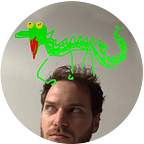The Highs and Lows of Emotion Maps
In a recent design exercise, where our team played Dungeons & Dragons for the first time (btw, awesome!), we set to to create a journey map where our Emotion Map anchored all of the other components. While it ended up looking pretty snappy, I realized that Emotion Maps are actually a pretty terrible tool.
Freaking Out
There are two major issues: Emotion Maps need a single axis that simplify emotions and it assumes that we can measure these emotions at least somewhat objectively. Unfortunately, both of these issues are difficult to solve.
Emotions are extraordinarily complicated and collapsing them onto one metric does a disservice to their complexity. For example, in Designing Pleasurable Products (2000), Jordan argues that there are four dimensions to pleasure, including the Physio (body and sensory), the Socio (relationships with people and wider society), Phycho (cognitive and emotional), and the Ideo (moral and ethical). Each one of these elements is fairly difficult to simplify as it is. Combining all four is foolhardy at best.
Moreover, since these emotions are so complex, it requires the design researcher to rely upon instinct to measure these emotions. These risks are magnified when the designer combines these measurements from multiple users and personas. Such ambiguity in what could be easily be misconstrued as a concrete process quickly devolves into “appeals to dark sciences” (Geertz, 1973).
Chilling Out
However, Emotion Maps should never be considered a silver bullet, or even something that is static. In this perspective, Emotion Maps quickly display correlations and outliers between a diversity of users, showing data in a new context. What is revealed are hints to the possibilities of causation, which should only serve as starting points for further investigation.
Validity is found when Emotion Maps are combined with other tools and techniques. These approaches often include supporting found-artifacts like comments and facial tracking, as well as cognitive mapping tools such as collaging, flowchart mapping, and velcro-modeling (Visser et al., 2005).
In fact, Emotion Maps, are now rarely used in a one-use practice and, as many other mapping techniques, are used iteratively throughout the entire design research process. In a participatory process, users are actively involved throughout the design process technique to prime users to initiate conversation, to understand the context that users are experiencing, and as a basis for idea generation (Sanders and Stappers, 2014).
In case you still really dislike Emotion Mapping, here’s some alternative techniques from Adaptive Path. First, map actions that individuals took and feedback that each action received. Next, map choices individuals took based on the location of each choice.
These are just some first thoughts, but I would appreciate hearing your own experience in making and using Emotion Maps.
Do you know what Experience Design is?
What do you know about Experience Design? Well then smarty pants, share your thoughts! We’re happy to publish pretty much anything on the topic. Comment here or send a reply and we’ll get the conversation going.
Bibliography:
Jordan, P. W. (2000) Designing Pleasurable Products. New York, USA: Taylor and Francis
Geertz, C. (1973) The interpretation of cultures: selected essays. New York, NY: New York, Basic Books [1973] Ch. 1 ‘Thick Description: Toward an Interpretative Theory of Culture’
Visser, F. S., Stappers, P. J., van der Lugt, R. and Sanders, E. B.-N. (2005) ‘Contextmapping: experiences from practice’, CoDesign, 1(2), pp. 119–149. doi: 10.1080/15710880500135987
Sanders, E. B.-N. and Stappers, P. J. (2014) ‘Probes, toolkits and prototypes: three approaches to making in codesigning’, CoDesign, 10(1), pp. 5–14. doi: 10.1080/15710882.2014.888183
